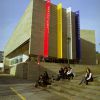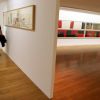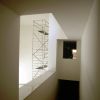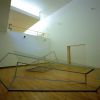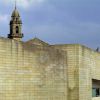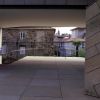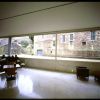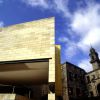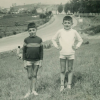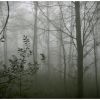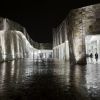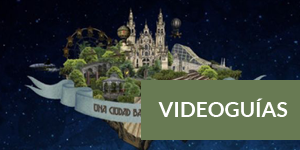- Accede I
- Regístrate I
- carrito
CGAC (Centro Galego de Arte Contemporánea)
Creado en 1993 y con programación estable desde 1995, el Centro Galego de Arte Contemporánea está situado en Santiago de Compostela, en el límite de la ciudad monumental, en un espacio mágico para los gallegos, compartiendo vecindad con el convento de San Domingos de Bonaval, donde se encuentra el Panteón de Gallegos Ilustres; con el Museo do Pobo Galego, recuerdo etnográfico de nuestra historia, además de constante puente y metáfora entre nuestros orígenes y la actualidad; y con un antiguo cementerio, recuperado por Álvaro Siza (con la colaboración de Isabel Aguirre) y convertido en sorprendente jardín de aires metafísicos, una presencia muy galaica del agua y una solución en explanadas y volúmenes que da sugerente réplica a los del centro.
El primer activo del CGAC es su arquitectura, diseñada por el portugués Álvaro Siza, en una cuidada conjunción de respeto exterior hacia el entorno y un sentido casi místico en su interior, de intensos contrastes entre limpios planos y los efectos de una luz siempre indirecta. Los espacios creados, tan arquitectónicamente bellos como difíciles cuando se trata de buscar soluciones expositivas, provocan que se establezca un constante diálogo (cómplice o tenso) entre artistas y arquitecto. Un diálogo muy propio del arte contemporáneo, de cuyas soluciones siempre sale beneficiado el espectador, que asiste a la resolución final del encuentro e intuye los puntos y momentos de auténtica tensión creativa.
El CGAC plantea sus actividades tanto en mostrar las líneas directrices del arte de las últimas décadas mediante retrospectivas de artistas que cuentan con un reconocimiento internacional generalizado y forman parte de la historia de estos años (el arquitecto Álvaro Siza, Giovanni Anselmo, Christian Boltanski, Felix Gonzalez-Torres, Vito Acconci, Ana Mendieta, Arnulf Rainer, Dan Graham, Giuseppe Penone, Jürgen Partenheimer, Robert Mangold, Helena Almeida, Rebecca Horn, Georges Rousse, Stephan Balkenhol, Alberto Carneiro, Antony Gormley, Richard Tuttle, Mona Hatoum), como en revisar la obra de artistas o momentos anteriores de giro estético (Medardo Rosso, Giuseppe Terragni, Marcel Broodthaers, Kurt Schwitters, Luis Buñuel, el cambio de siglo en la pintura parisina...) Tampoco se olvidan, lógicamente, colectivas de tesis (Itínere, Signos y milagros, Imágenes y visiones, Outra mirada, Minimal Maximal, Lost in Sound, De Warhol a Cabrita Reis, Transfer, Mondophrenetic, Garaje, Oito relatos nórdicos) o revisiones críticas de los nombres que marcan los momentos más intensos del arte gallego de este siglo (Maruja Mallo, Laxeiro, Leopoldo Nóvoa, Alberto Datas, Carlos Alcolea, Rafael Baixeras, Luís Seoane, Francisco Leiro, Jorge Castillo).
Un notorio dinamismo suponen las intervenciones y los proyectos específicos, preparados pensando en las especiales condiciones del CGAC por artistas más jóvenes, tanto gallegos (Isaac Pérez Vicente, Antón Patiño, Antón Lamazares, Ánxel Huete, Jorge Barbi, Berta Cáccamo, Santiago Mayo, Vari Caramés, Pamen Pereira, Salvador Cidrás, Mónica Alonso,Xoán Anleo, Antonio Murado, Manuel Vilariño) como foráneos (Juan Muñoz, Perejaume, Nacho Criado, Anish Kapoor, Adolfo Schlosser, Hans Hemmert, Frank Thiel, Johan Grimonprez, Chema Madoz, Humberto Rivas, James Casebere, Tracey Moffatt, Elisa Sighicelli, Loris Cecchini, José Antonio Hernández-Diez, Florence Paradeis, Sarah Dobai, Darío Villalba, Peter Wüthrich, Efrain Almeida, Gillian Wearing, Ernesto Neto, Marine Hugonnier, Juan Navarro Baldeweg, Josiah McElheny).
Los ciclos de conferencias, los talleres impartidos por artistas, los debates públicos entre artistas y críticos, la programación de una plataforma de vídeo, las consultas de sus actividades a través de Internet (www.cgac.org), las incursiones en el campo de la música, la danza, la literatura, el teatro o el cine conforman el día a día inexcusable de un centro que quiere ser ante todo un espacio activo.
Una cuidada línea editorial, encaminada tanto a la producción de catálogos y una revista sobre las actividades del centro, como la preparación de material didáctico y folletos.
















